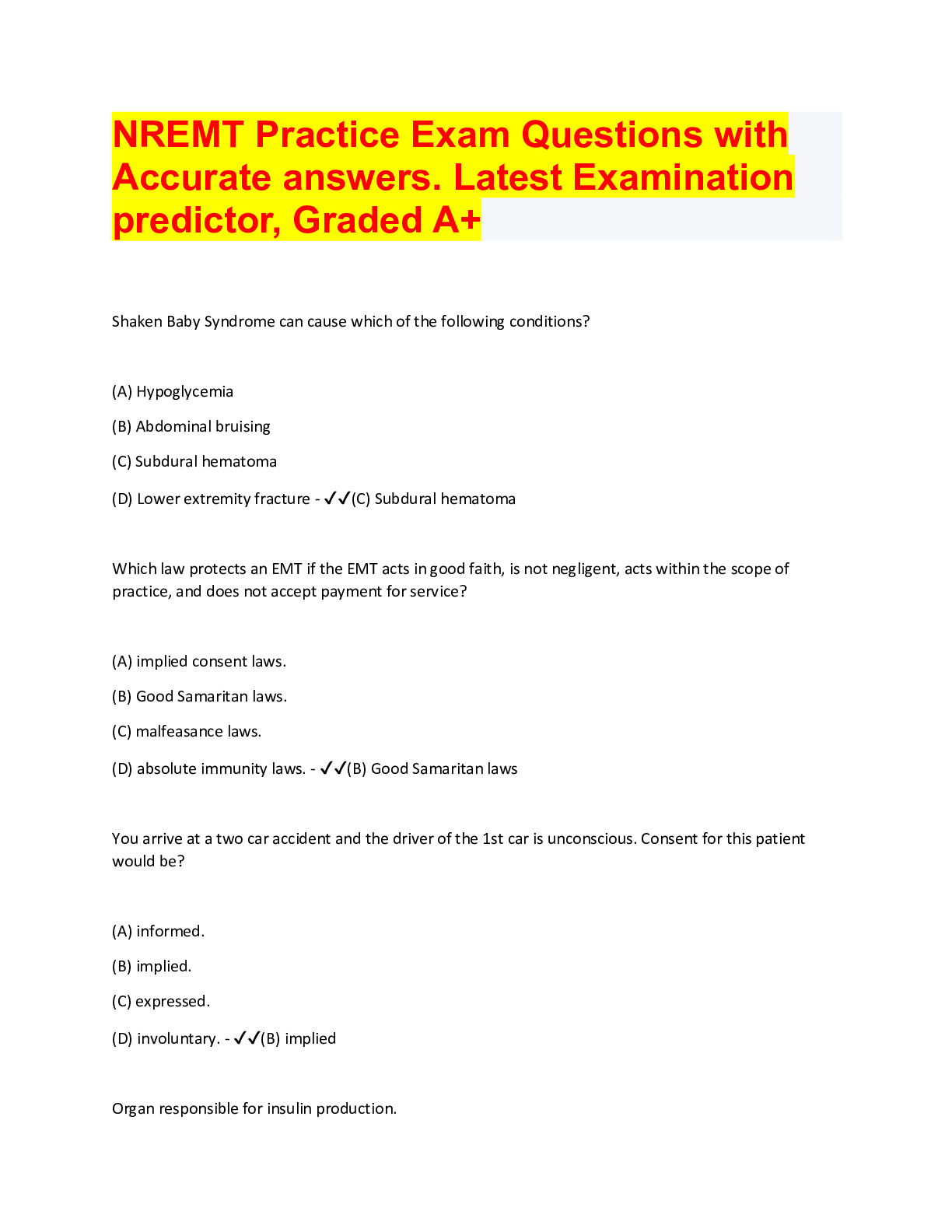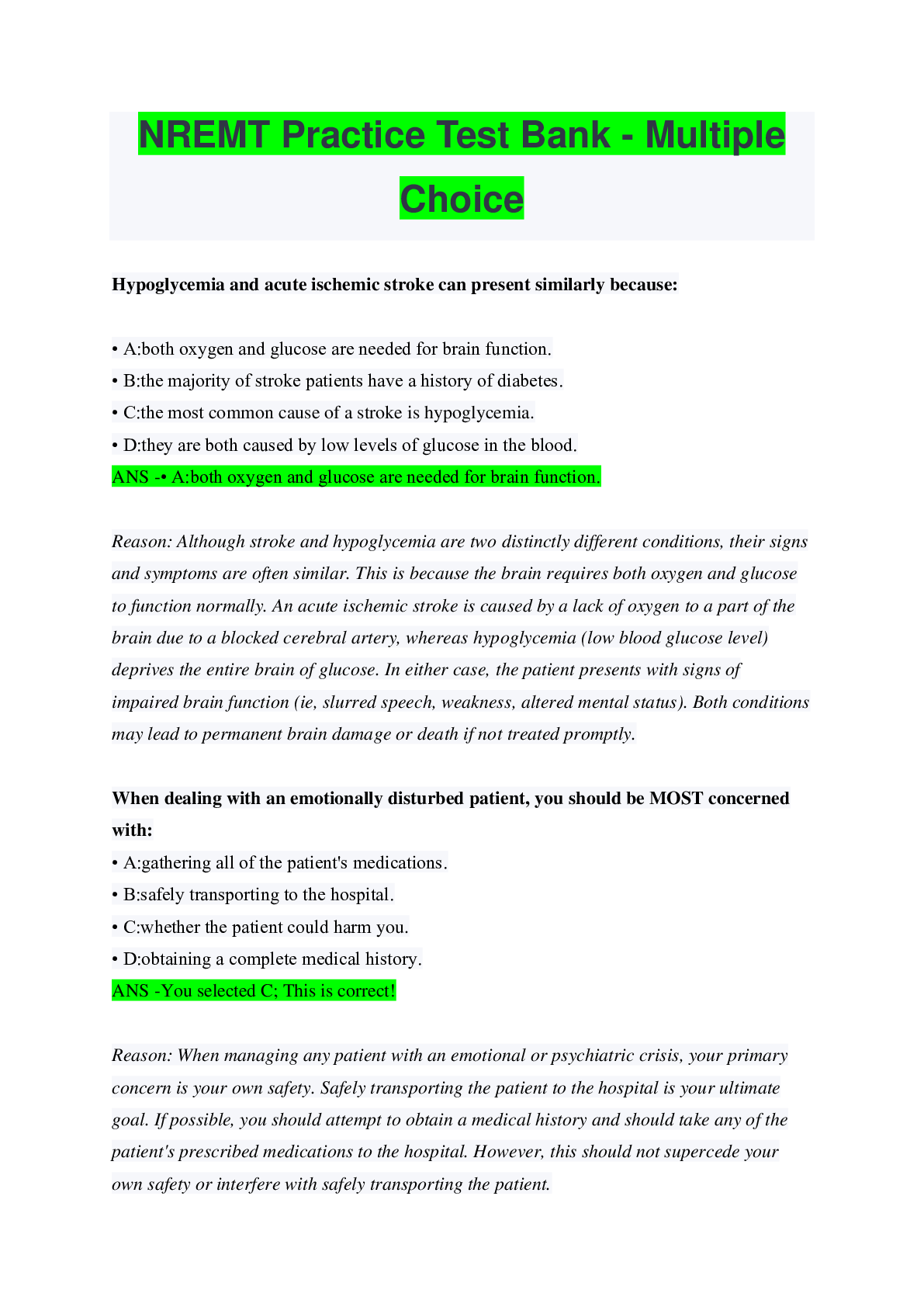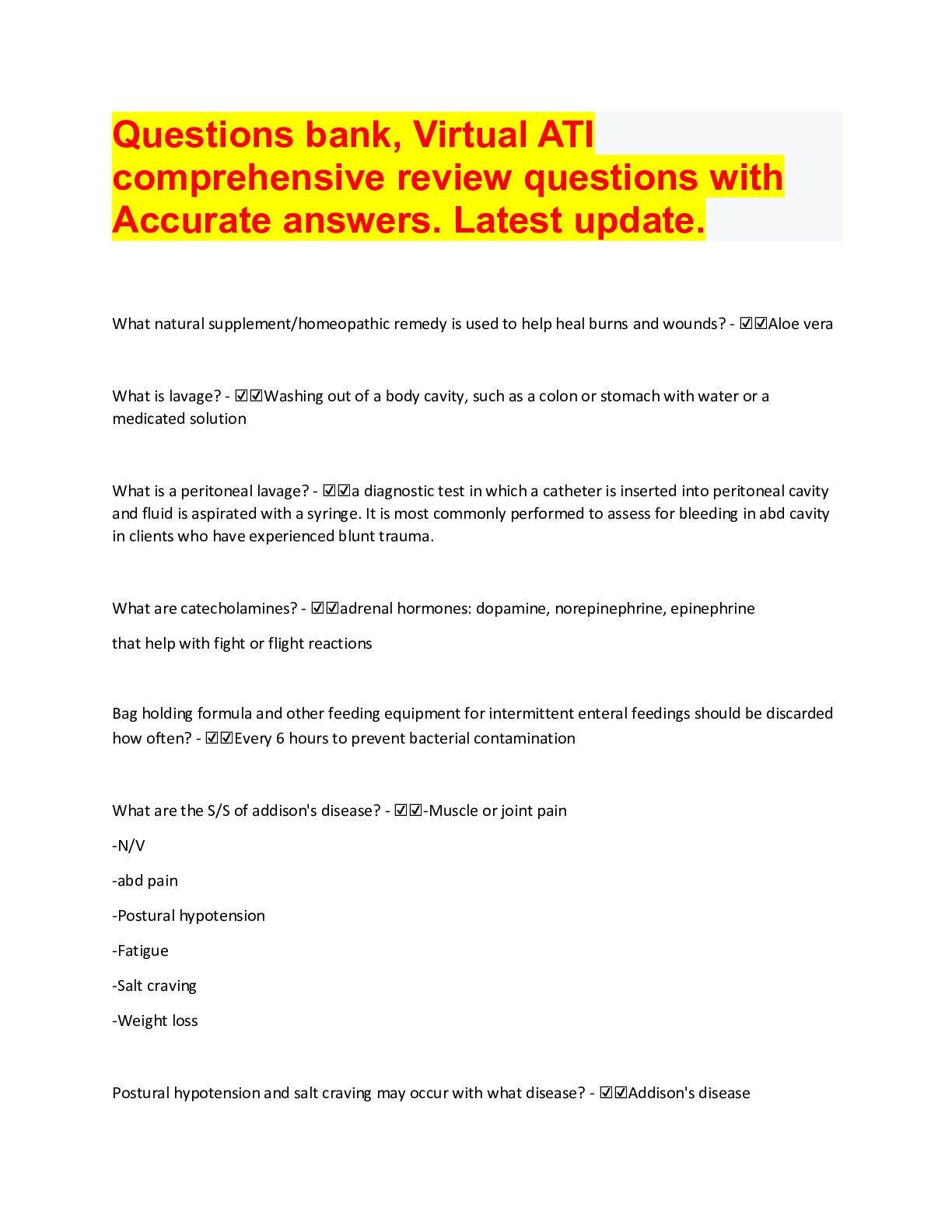Information Technology > QUESTIONS & ANSWERS > AWS Services, Questions with accurate answers. 100% verified. Rated A. Quiz Bank with answers (All)
AWS Services, Questions with accurate answers. 100% verified. Rated A. Quiz Bank with answers
Document Content and Description Below
Amazon EC2 - ✔✔Amazon Elastic Compute Cloud (Amazon EC2) is a web service that provides resizeable computing capacity—literally, servers in Amazon's data centers—that you use to build and host... your software systems. Amazon ECR - ✔✔Amazon Elastic Container Registry (Amazon ECR) is a fully managed Docker container registry that makes it easy for developers to store, manage, and deploy Docker container images. Amazon ECS - ✔✔Amazon Elastic Container Service (Amazon ECS) is a highly scalable, fast, container management service that makes it easy to run, stop, and manage Docker containers on a cluster of Amazon EC2 instances. Amazon Lightsail - ✔✔Amazon Lightsail is the easiest way to get started with AWS for developers who just need virtual private servers. Lightsail includes everything you need to launch your project quickly - a virtual machine, SSD-based storage, data transfer, DNS management, and a static IP - for a low, predictable price. Amazon VPC - ✔✔Amazon Virtual Private Cloud (Amazon VPC) enables you to launch Amazon Web Services (AWS) resources into a virtual network that you've defined. This virtual network closely resembles a traditional network that you'd operate in your own data center, with the benefits of using the scalable infrastructure of AWS. AWS Batch - ✔✔AWS Batch enables you to run batch computing workloads on the AWS Cloud. Batch computing is a common way for developers, scientists, and engineers to access large amounts of compute resources. AWS Batch removes the undifferentiated heavy lifting of configuring and managing the required infrastructure. AWS Elastic Beanstalk - ✔✔With AWS Elastic Beanstalk, you can quickly deploy and manage applications in the AWS Cloud without worrying about the infrastructure that runs those applications. AWS Elastic Beanstalk reduces management complexity without restricting choice or control. You simply upload your application, and AWS Elastic Beanstalk automatically handles the details of capacity provisioning, load balancing, scaling, and application health monitoring. AWS Lambda - ✔✔With AWS Lambda, you can run code without provisioning or managing servers. You pay only for the compute time you consume—there's no charge when your code isn't running. You can run code for virtually any type of application or backend service—all with zero administration. Just upload your code and Lambda takes care of everything required to run and scale your code with high availability. You can set up your code to automatically trigger from other AWS services or call it directly from any web or mobile app. AWS Serverless Application Repository - ✔✔With AWS Serverless Application Repository, you can quickly find and deploy serverless applications in the AWS Cloud. You can browse applications by category, or search for them by name, publisher, or event source. To use an application, you simply select it, configure required fields, and deploy it with a few clicks. As a serverless application developer, you can also easily publish applications, sharing them across teams and organizations and with other AWS users. To publish serverless applications, you can use the AWS Management Console, AWS CLI, or AWS SDKs to upload the code, along with a simple manifest file. Amazon S3 - ✔✔Amazon Simple Storage Service (Amazon S3) is storage for the Internet. You can use Amazon S3 to store and retrieve any amount of data at any time, from anywhere on the web. You can accomplish these tasks using the simple and intuitive web interface of the AWS Management Console. Amazon EBS - ✔✔Amazon Elastic Block Store (Amazon EBS) provides block level storage volumes for use with EC2 instances. EBS volumes are highly available and reliable storage volumes that can be attached to any running instance that is in the same Availability Zone. EBS volumes that are attached to an EC2 instance are exposed as storage volumes that persist independently from the life of the instance. With Amazon EBS, you pay only for what you use. For more information about Amazon EBS pricing, see the Projecting Costs section of the Amazon Elastic Block Store page. Amazon EBS is recommended when data must be quickly accessible and requires long-term persistence. EBS volumes are particularly well-suited for use as the primary storage for file systems, databases, or for any applications that require fine granular updates and access to raw, unformatted, block-level storage. Amazon EBS is well suited to both database-style applications that rely on random reads and writes, and to throughput-intensive applications that perform long, continuous reads and writes. For simplified data encryption, you can launch your EBS volumes as encrypted volumes. Amazon EBS encryption offers you a simple encryption solution for your EBS volumes without the need for you to build, manage, and secure your own key management infrastructure. When you create an encrypted EBS volume and attach it to a supported instance type, data stored at rest on the volume, disk I/O, and snapshots created from the volume are all encrypted. The encryption occurs on the servers that hosts EC2 instances, providing encryption of data-in-transit from EC2 instances to EBS storage. For more information, see Amazon EBS Encryption. Amazon EBS encryption uses AWS Key Management Service (AWS KMS) master keys when creating encrypted volumes and any snapshots created from your encrypted volumes. The first time you create an encrypted EBS volume in a region, a default master key is created for you automatically. This key is used for Amazon EBS encryption unless you select a Customer Master Key (CMK) that you created separately using the AWS Key Management Service. Creating your own CMK gives you more flexibility, including the ability to create, rotate, disable, define access controls, and audit the encryption keys used to protect your data. For more information, see the AWS Key Management Service Developer Guide. You can attach multiple volumes to the same instance within the limits specified by your AWS account. Your account has a limit on the number of EBS volumes that you can use, and the total storage available to you. For more information about these limits, and how to request an increase in your limits, see Request to Increase the Amazon EBS Volume Limit. Amazon Elastic File System - ✔✔Amazon EFS provides file storage for your Amazon EC2 instances. With Amazon EFS, you can create a file system, mount the file system on your EC2 instances, and then read and write data from your EC2 instances to and from your file system. Amazon Glacier - ✔✔Amazon Glacier is a storage service optimized for infrequently used data, or "cold data." The service provides durable and extremely low-cost storage with security features for data archiving and backup. With Amazon Glacier, you can store your data cost effectively for months, years, or even decades. Amazon Glacier enables you to offload the administrative burdens of operating and scaling storage to AWS, so you don't have to worry about capacity planning, hardware provisioning, data replication, hardware failure detection and recovery, or time-consuming hardware migrations. AWS Snowball - ✔✔AWS Snowball is a service for customers who want to transport terabytes or petabytes of data to and from AWS, or who want to access the storage and compute power of the AWS Cloud locally and cost effectively in places where connecting to the internet may not be an option. AWS Storage Gateway - ✔✔AWS Storage Gateway is a service that connects an on-premises software appliance with cloud-based storage to provide seamless and secure integration between your on-premises IT environment and the AWS storage infrastructure in the cloud. Amazon DynamoDB - ✔✔Amazon DynamoDB is a fully managed NoSQL database service that provides fast and predictable performance with seamless scalability. You can use Amazon DynamoDB to create a database table that can store and retrieve any amount of data, and serve any level of request traffic. Amazon DynamoDB automatically spreads the data and traffic for the table over a sufficient number of servers to handle the request capacity specified by the customer and the amount of data stored, while maintaining consistent and fast performance. Amazon ElastiCache - ✔✔Amazon ElastiCache is a web service that makes it easy to set up, manage, and scale distributed in-memory cache environments in the AWS Cloud. It provides a high performance, resizeable, and cost-effective in-memory cache, while removing the complexity associated with deploying and managing a distributed cache environment. Amazon Neptune - ✔✔Amazon Neptune is a fast, reliable, fully managed graph database service that makes it easy to build and run applications that work with highly connected datasets. The core of Neptune is a purpose-built, high-performance graph database engine that is optimized for storing billions of relationships and querying the graph with milliseconds latency. Neptune supports the popular graph query languages Apache TinkerPop Gremlin and W3C's SPARQL, allowing you to build queries that efficiently navigate highly connected datasets. Neptune powers graph use cases such as recommendation engines, fraud detection, knowledge graphs, drug discovery, and network security. Amazon RDS - ✔✔Amazon Relational Database Service (Amazon RDS) is a web service that makes it easier to set up, operate, and scale a relational database in the cloud. It provides cost-efficient, resizable capacity for an industry-standard relational database and manages common database administration tasks. Amazon Redshift - ✔✔Amazon Redshift is a fast, fully managed, petabyte-scale data warehouse service that makes it simple and cost-effective to efficiently analyze all your data using your existing business intelligence tools. It is optimized for datasets ranging from a few hundred gigabytes to a petabyte or more and costs less than $1,000 per terabyte per year, a tenth the cost of most traditional data warehousing solutions. AWS Application Discovery Service - ✔✔The AWS Application Discovery Service helps systems integrators quickly and reliably plan application migration projects by automatically identifying applications running in on-premises data centers, their associated dependencies, and their performance profile. AWS Database Migration Service - ✔✔AWS Database Migration Service Documentation AWS Database Migration Service is a web service you can use to migrate data from your database that is on-premises, on an Amazon Relational Database Service (Amazon RDS) DB instance, or in a database on an Amazon Elastic Compute Cloud (Amazon EC2) instance to a database on an AWS service. These services can include a database on Amazon RDS or a database on an Amazon EC2 instance. You can also migrate a database from an AWS service to an on-premises database. You can migrate data between heterogeneous or homogenous database engines. AWS Import/Export - ✔✔AWS Import/Export is a service that accelerates transferring data into and out of AWS using physical storage appliances, bypassing the Internet. AWS Import/Export Disk was originally the only service offered by AWS for data transfer by mail. Disk supports transfers data directly onto and off of storage devices you own using the Amazon high-speed internal network. If you're looking for documentation on AWS Snowball, a service used to transport terabytes or petabytes of data, see AWS Snowball Documentation. AWS Migration Hub - ✔✔AWS Migration Hub provides a single location to track migration tasks across multiple AWS tools and partner solutions. With Migration Hub, you can choose the AWS and partner migration tools that best fit your needs while providing visibility into the status of your migration projects. Migration Hub also provides key metrics and progress information for individual applications, regardless of which tools are used to migrate them. AWS SMS - ✔✔AWS Server Migration Service (AWS SMS) combines data collection tools with automated server replication to speed the migration of on-premises servers to AWS. AWS Schema Conversion Tool - ✔✔The AWS Schema Conversion Tool makes heterogeneous database migrations easy by automatically converting the source database schema and a majority of the custom code to a format compatible with the target database. The custom code that the tool converts includes views, stored procedures, and functions. Any code that the tool cannot convert automatically is clearly marked so that you can convert it yourself. For supported source and target databases, see the User Guide, following. Amazon VPC - ✔✔Amazon Virtual Private Cloud (Amazon VPC) enables you to launch Amazon Web Services (AWS) resources into a virtual network that you've defined. This virtual network closely resembles a traditional network that you'd operate in your own data center, with the benefits of using the scalable infrastructure of AWS. Amazon CloudFront - ✔✔Amazon CloudFront is a web service that speeds up distribution of your static and dynamic web content, for example, .html, .css, .php, image, and media files, to end users. CloudFront delivers your content through a worldwide network of edge locations. When an end user requests content that you're serving with CloudFront, the user is routed to the edge location that provides the lowest latency, so content is delivered with the best possible performance. If the content is already in that edge location, CloudFront delivers it immediately. If the content is not currently in that edge location, CloudFront retrieves it from an Amazon S3 bucket or an HTTP server (for example, a web server) that you have identified as the source for the definitive version of your content. Amazon Route 53 - ✔✔Amazon Route 53 is a highly available and scalable Domain Name System (DNS) web service. Amazon API Gateway - ✔✔Amazon API Gateway is a fully managed service that makes it easy for developers to publish, maintain, monitor, and secure APIs at any scale. Create an API to access data, business logic, or functionality from your back-end services, such as applications running on Amazon Elastic Compute Cloud (Amazon EC2), code running on AWS Lambda, or any web application. AWS Direct Connect - ✔✔AWS Direct Connect links your internal network to an AWS Direct Connect location over a standard 1 gigabit or 10 gigabit Ethernet fiber-optic cable. One end of the cable is connected to your router, the other to an AWS Direct Connect router. With this connection in place, you can create virtual interfaces directly to the AWS cloud and Amazon Virtual Private Cloud, bypassing Internet service providers in your network path. Elastic Load Balancing - ✔✔Elastic Load Balancing automatically distributes your incoming application traffic across multiple targets, such as EC2 instances. It monitors the health of registered targets and routes traffic only to the healthy targets. Elastic Load Balancing supports three types of load balancers: Application Load Balancers, Network Load Balancers, and Classic Load Balancers. AWS CodeStar - ✔✔AWS CodeStar lets you quickly develop, build, and deploy applications on AWS. AWS CodeCommit - ✔✔AWS CodeCommit is a version control service that enables you to privately store and manage Git repositories in the AWS cloud. AWS CodeBuild - ✔✔AWS CodeBuild is a fully managed build service that compiles your source code, runs unit tests, and produces artifacts that are ready to deploy. AWS CodeDeploy - ✔✔AWS CodeDeploy is a deployment service that enables developers to automate the deployment of applications to instances and to update the applications as required. AWS CodePipeline - ✔✔AWS CodePipeline is a continuous delivery service that enables you to model, visualize, and automate the steps required to release your software. AWS Cloud9 - ✔✔AWS Cloud9 is a cloud-based integrated development environment (IDE) that you use to write, run, and debug code. AWS X-Ray - ✔✔AWS X-Ray makes it easy for developers to analyze the behavior of their distributed applications by providing request tracing, exception collection, and profiling capabilities. AWS Tools & SDKs - ✔✔This index highlights the primary developer tools, SDKs, IDE Toolkits, and Command Line Tools for developing and managing your AWS applications. Amazon CloudWatch - ✔✔Amazon CloudWatch provides a reliable, scalable, and flexible monitoring solution that you can start using within minutes. You no longer need to set up, manage, and scale your own monitoring systems and infrastructure. Use CloudWatch to monitor your AWS resources and the applications you run on AWS in real time. Use CloudWatch Events to send system events from AWS resources to AWS Lambda functions, Amazon SNS topics, streams in Amazon Kinesis, and other target types. Use CloudWatch Logs to monitor, store, and access your log files from Amazon EC2 instances, AWS CloudTrail, or other sources. AWS Auto Scaling - ✔✔With AWS Auto Scaling, you can quickly discover the scalable AWS resources for your application and set up dynamic scaling. It uses Amazon EC2 Auto Scaling to scale your EC2 instances and Application Auto Scaling to scale resources from other services. AWS CloudFormation - ✔✔AWS CloudFormation enables you to create and provision AWS infrastructure deployments predictably and repeatedly. It helps you leverage AWS products such as Amazon EC2, Amazon Elastic Block Store, Amazon SNS, Elastic Load Balancing, and Auto Scaling to build highly reliable, highly scalable, cost-effective applications in the cloud without worrying about creating and configuring the underlying AWS infrastructure. AWS CloudFormation enables you to use a template file to create and delete a collection of resources together as a single unit (a stack). AWS CloudTrail - ✔✔With AWS CloudTrail, you can monitor your AWS deployments in the cloud by getting a history of AWS API calls for your account, including API calls made via the AWS Management Console, the AWS SDKs, the command line tools, and higher-level AWS services. You can also identify which users and accounts called AWS APIs for services that support CloudTrail, the source IP address the calls were made from, and when the calls occurred. You can integrate CloudTrail into applications using the API, automate trail creation for your organization, check the status of your trails, and control how administrators turn CloudTrail logging on and off. AWS Config - ✔✔AWS Config provides a detailed view of the resources associated with your AWS account, including how they are configured, how they are related to one another, and how the configurations and their relationships have changed over time. AWS OpsWorks - ✔✔AWS OpsWorks provides a simple and flexible way to create and manage stacks and applications. With AWS OpsWorks, you can provision AWS resources, manage their configuration, deploy applications to those resources, and monitor their health. AWS Service Catalog - ✔✔AWS Service Catalog allows IT administrators to create, manage, and distribute portfolios of approved products to end users, who can then access the products they need in a personalized portal. Typical products include servers, databases, websites, or applications that are deployed using AWS resources (for example, an Amazon EC2 instance or an Amazon RDS database). You can control which users have access to specific products to enforce compliance with organizational business standards, manage product lifecycles, and help users find and launch products with confidence. AWS Systems Manager - ✔✔Use AWS Systems Manager to organize, monitor, and automate management tasks on your AWS resources. AWS Support - ✔✔AWS Support provides support for users of Amazon Web Services. All users have access to account and billing help in the AWS Support Center. In addition, customers with some support plans have access to additional features, including AWS Trusted Advisor and an API for programmatic access to support cases and Trusted Advisor. [Show More]
Last updated: 1 year ago
Preview 1 out of 27 pages

Also available in bundle (1)

AWS bUNDLE. ALL EXAMINABLE QUESTIONS WITH ANSWERS. PASS EASY.
ALL AWS PAPERS. QUESTIONS WITH ANSWERS. RATED A
By Topmark 1 year ago
$32
28
Reviews( 0 )
Document information
Connected school, study & course
About the document
Uploaded On
Oct 14, 2022
Number of pages
27
Written in
Additional information
This document has been written for:
Uploaded
Oct 14, 2022
Downloads
0
Views
83


































